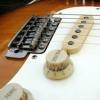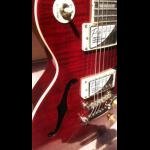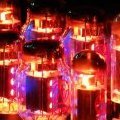Leaderboard
Popular Content
Showing content with the highest reputation since 09/28/2024 in all areas
-
Hi So, I have updated my cheat sheet (pdf-version) and for you who are interested just download it from the link below (from my Dropbox). All the new amp’s, cab’s and effects are in there, marked with a red “N”, incl DSP and some other additional info. Legacy devices are marked with a red “L”. All are sorted in order of appearance on the unit, in their respective group. DSP-values for the new products are from me, but I have used the same method as Ben Vesco has used, published, and described very well on his great site (unfortunately not updated). If anyone has found a value that differs from mine, please let me know. There is a slight difference depending on which blocks are used when trying out the numbers. I have used blocks from Ben’s “reference material” to minimize errors and to get continuity. I have used two different setups and if those have a variation bigger than 0,5 (in relative %) I have used a third setup. Think it’s hard to get any closer. “Last device” is always at least one volume pedal at the end, in mono (0,47%) and/or in stereo (0,61%), what’s ever slips in :-), so that would be the tolerance... All devices are in preamp/full amp (cab’s are not incl, presented separate, but as default cab’s incl DSP, are in the sheet with the amp’s), stereo/mono, single/dual etc. where applicable. In an earlier version I did also publish the cheat sheet in a MS Excel 365 format, a DSP calculator. I will make that update but need some more time to finish it (want to play some guitar too…). Download the cheat sheet from my Dropbox (pdf-format) – https://www.dropbox.com/scl/fi/8vsyuiehgd6ofjryw6g9q/Line6-Helix-Model-and-DSP-Summary-3-70.pdf?rlkey=k3yyscizqbi1z80ozmo6gsihi&dl=0 https://www.dropbox.com/scl/fi/3ye2g1okvx18ypsww746w/Line6-Helix-Model-and-DSP-Summary-3.80.pdf?rlkey=8ygh0iqax8ewds0i3yn0nxc86&dl=0 Great update Line6, very impressive work. Thought I had all I needed before this update, but was I wrong, there were a few more I didn’t know about, eg. the US Dripman (!), some of the Catalyst amp’s, 2203 and the ODR-1, wow :-) Have fun (I will…)! //Per8 points
-
I certainly do consider what Line 6 has done: 10-year-old technology (based on the even older technology available during development) has received multiple updates, including two that I consider truly major - global oversampling and reworked cabs. The reworked cabs update was only two years ago. And you have the massively improved pitch transposition, feedback effect, and significant new effects like the auto level control dynamics. It's easy to forget that snapshots, impulse responses, favorites, and other useful features we take for granted now were updates as well. As far as I'm concerned, Line 6 delivered on their promise of a platform, not just an effects processor, with multiple significant updates over the course of a 10-year product life. That's rare, and all the updates were free, too. I can think of very few companies with a similar track record. I don't judge a product by what it doesn't do as much as I judge it by what it does.7 points
-
https://youlean.co/youlean-loudness-meter/ is a great tool for preset leveling.5 points
-
I'm the author. I wanted to give a heads-up that the book has been through four free updates, but there will be another free update after the next Helix firmware becomes available. To obtain the update, all you need to do is download the book again. Whatever you download will always be the most current update. Updates cover the features from new firmware, but they also include more applications for new and existing features. To find out what people think, check out the reader reviews on the Sweetwater site. They've all been extremely positive except for a couple people who expected it to be a "Helix 101" book for beginners. It is not. It's written to cover what's not in the manual, describe applications (e.g., virtual "Nashville tuning"), and provide technical information about the blocks that isn't available anywhere else. The original reason for writing the book was because the manual didn't describe what the block parameters actually do. The only other caveat is the presets. Not all are meant to be "plug and play." Some are simply designed to show a particular technique, so you load them to experiment with something described in the text. Then using what you learned from reading the book, you can modify them for your specific needs. Scroll down the book's landing page and you'll see the contents toward the bottom. The topics that are covered will help you decide if you want to go deep into maximizing the Helix's potential, or need something more introductory.5 points
-
You'll never get an answer. Line 6 doesn't give a damn about its users.4 points
-
Hi, Yes, no problem, providing you are using the latest version of the Firmware there shouldn't be any issues. Connect your Helix to your computer via USB, then simply drag and drop the preset .hlx file into an empty "New Preset" slot (or overwrite and existing one). It should then appear on your hardware. Done. Note: The Helix uses 2 DSP chips whereas the the HX Stomp is limited to a single chip. This means that a preset intended for use on the Stomp, or XL, can only occupy blocks on a single path. It is also possible to create a preset on your Helix which uses only a single path, and provided it doesn't exceed the single DSP and block usage, it can be used in a single chip unit. Hope this helps/makes sense.4 points
-
Well, at least I think it's cool :) A lot of people like to layer guitar power chords. I don't, because I think it makes the part lose focus. But I do like big guitar sounds, especially for power chords. So, here's a studio technique I stumbled on that creates a layered sound, but doesn't lose focus: In one Helix path, split the guitar through two different, but similar amp+cabs. Pan one amp hard left and one amp hard right. This should give a big stereo image. If not, the cabs probably aren't different enough Dedicate the other path to an undistorted guitar sound, and pan it to the center. Use effects on the undistorted guitar like chorus, delay, reverb, whatever. Mix the center so it blends well with the amps. The effects on the undistorted guitar add a clarity to the sound's processing you normally don't have when adding effects to distorted amps. The undistorted guitar path is the key to making this faux-layered sound work, because it provides a defined, clear sound that complements the sludge of distorted power chords. There's a sweet spot for this level - soft enough not to dominate, but loud enough to contribute to the overall sound. (Also note that this technique steals a page from LCR mixing techniques.) The bottom line is you now have three layered guitar sounds, but only one guitar part. This retains the part's focus by avoiding potential conflicts among multiple parts. Try it!4 points
-
I'm sorry to hear that, let's see if we can fix it. First of all, was including the contents for all the chapters on the Sweetwater site not sufficient? I did that so people would know what topics to expect. But second, and more importantly, these books are updated frequently. If you can describe what would make the book more helpful, that could provide guidance on additional material to include. The book isn't going away any time soon, there will definitely be more updates. Many reader suggestions have gone into the updates since v1.0. Note that I try not to include material that's already covered in the manual, or is well-represented in videos on YouTube. The goal is to supplement the manual with more details about effects, and more applications. However, the reality is if there's something you think it missing, then it's probably missing for some other people who didn't take the time to write in. This is why I solicit feedback. I am committed to making this book at helpful as a possibly can, but I can't always guess what people want. If for some reason you don't want to do a public reply, you can use the contact email provided in the book.4 points
-
The "best" sounding FRFR (a meaningless marketing term) for anything is so subjective as to be a pointless discussion. See TGP for dozens of such. I have a PC212+, HR FRFR112 and Rokit 6 studio monitors. They all sound good for different things and at different levels. The "best" sounding FRFR speaker is the one that YOU like best for YOUR application in YOUR listening environment. Which means that YOU would have to try them ALL to know which is "best". I know, not the answer you wanted. I mostly play my Helix through my Catalyst100 without IRs. If I played more "metal" I'd get a closed back cab and separate amp. For as often as I play that style, running the XLR Out from the Cat with emulation OFF into the PC212+ with speaker emulation (not FRFR) sounds good enough. YMMV.4 points
-
After posting the same advice over and over and over throughout the last years (and for several times just during the last hours), I decided to post this here, so I can just link to it (it's also missing in any official Line 6 documentation, at least in a direct, straight ahead form). So, your update to whatever firmware failed? The following steps helped TONS of people over the last years, so give them a try. Note: I am assuming that you've backed up your HX family device already. In case you haven't, now is the time. But as your update possibly failed already, you won't be able to do so, then just proceed (and let's hope you've backed up before). 1) Shut down HX Edit (using it was likely the reason for the update not to work in the first place, so don't use it this time). Windows users *need* (<-!!!) to make sure no traces of it are running in the background anymore. You can either kill the process by using the task manager, in case you don't know how to do that, just reboot your computer. Again: It is ABSOLUTELY mandatory for the following steps to work that there's NO HX Edit or traces of it running. 2) Go to this site: https://line6.com/software/ Download the Line 6 Updater this way: That will take you to the site with the actual download (I'm not posting that link because there's various operating systems supported). 3) Install the Line 6 Updater. Edit: Mac users, in case you're running into troubles installing things, please read the bottom of this post. 4) Go to this page again: https://line6.com/software/ This time, download the actual firmware this way: Make ABSOLUTELY sure you select your hardware properly! Again, clicking "Go" will take you to the actual download page. Note: The file you will be downloading comes with a "hxf" file ending, make sure to remember the location you've downloaded that file to, you will need to know soon enough! 5) Connect your HX familiy device. Edit: 6) This*might* not be necessary, also, in case your unit really seems bricked, it might not work, but just to make sure, enter safe-boot (aka update mode). Here's how (copied from elsewhere on this site): - Helix Floor/LT: enter update mode manually by holding footswitches 6 + 12 - Helix Rack: ENC1 & ENC6 - will enter Update Mode (This feature is only available on firmware v1.06.5 and higher) - HX Effects: Holding the right arrow ">" Will put the unit in a fail safe update mode. Use this when the HX Effects is in a un-recoverable state - HX Stomp and Stomp XL: Page >: update mode. This update mode is helpful if the update is interrupted, and the HX Stomp will not boot properly. (this will apparently cause a blank screen) 7) Start the Line 6 Updater you've just installed (well, maybe you've installed it already in the past, just start it...). 8) DON'T sign in, chose "Offline Mode" (<-!!!). 9) On the following page, your device(s) should appear. If that's not happening, check whether they're properly connected to a dedicated USB port and not to some fancy HUB. Also check that the USB cable you're using is of decent quality. In case you've checked all that but your device still doesn't show up, quit reading this thread and look for another computer to try with, the following procedure obviously only works as long as your devices are detected by your computer (yeah, I know this sounds like "computing 101 nanny" stuff, but be it so...). 10) Select your device, just click on it. 11) In the following dialog, click here: In the following open dialog, navigate to the file you've downloaded in step (4). Make ABSOLUTELY sure it's indeed the file you've downloaded and not some earlier version or something for another device. 12) Click "Update". This might take a while, as can be read here: Wohoo! Once done, make sure you've got the latest version of HX Edit installed. In case you haven't, grab it from here again: https://line6.com/software/ Following page will take you to the actual download. Download and install. 13) Perform a factory reset before booting into HX Edit. Might not be required all the time but Line 6 recommends doing so. In case you didn't manage to do a backup before the trouble started, you might however want to do that now and then perform a factory reset. Here's the procedures for the various HX family products: Helix Floor/LT: While holding footswitches 9 & 10 (bottom row, 2 middle switches), turn on Helix Floor/LT Helix Rack: While holding knobs 5 & 6 (2 furthest right knobs below the screen), turn on Helix Rack HX Effects: While holding footswitches 6 & TAP (2 farthest right switches on the bottom row), turn on HX Effects HX Stomp: While holding footswitches 2 & 3, turn on HX Stomp HX Stomp XL: While holding footswitches C & D, turn on HX Stomp That should be it. Yeah, as said, computer nanny kinda stuff, but then, this really isn't explained too well officially (the official procedure is online updating via HX Edit, which seems to fail often enough to justify writing my little installment). Good luck! Edit: Quite obviously, in case everything worked, you might want to reload your backup onto your device, using HX Edit. Edit #2 To all Mac users running a macOS version from Catalina and onwards: Apple has added several security measures, starting with Catalina. In case an application (in this case most likely the Line 6 Updater, which I think hasn't seen an update to itself for a while, whereas HX Edit should usually just install fine) comes up with whatever error message when doubleclicking the installer, as a first step, try to do a rightclick and select "open". You will likely see a warning but it'll often allow you to click onto something saying "yes, open anyway". In case that doesn't work, it might take you to the security settings straight away. But apparently, sometimes it doesn't. As I'm still running Mojave at the time of writing this, I can't tell you the exact procedure, so here's some information: https://support.apple.com/en-us/HT202491 Thanks to @datacommandofor pointing me to those.4 points
-
Below you find a link to the updated cheat sheet, now updated with the nice stuff brought to us in the Line 6 firmware 3.80-update. I have used Ben Vesco's method to calculate the relative DSP values. Technical info in the pdf that was not published by Line 6 has been explored through available info from manufacturers, forums and other "reliable" sources. If you find something wrong/strange don't hesitate to let me know. Download the cheat sheet from my Dropbox (pdf-format) – https://www.dropbox.com/scl/fi/3ye2g1okvx18ypsww746w/Line6-Helix-Model-and-DSP-Summary-3.80.pdf?rlkey=8ygh0iqax8ewds0i3yn0nxc86&dl=0 Some of you have used my DSP calculation tool in Microsoft Excel. I have decided to put this tool on hold for now. The reason is that I found myself making the calculation I need from this pdf-document, quicker and more "on the fly". I had some other ideas to include too, but that will be later... Hope you find it useful. And Line6, I have left space for at least 30 more amps, cabs and effects in future updates... :-) /Per4 points
-
The real Bogner Ecstasy is a $3500 amp that has more knobs, buttons and switches than any amp I've ever seen, so I'm betting they spent as much time to create that one amp as it takes to create a dozen simpler amps. I don't know if I'll use the Helix version, but I bet a lot of people will. So I'd look at this as a quality over quantity situation. After all, whatever favorite amps you have in the Helix so far, aren't you glad they got them right?4 points
-
4 points
-
If I were buying an FRFR today... I'd lean to the Fender line. They sound great and have those familiar controls of an amp for quick room/stage compensation without diving into menus. That said... my AITR tones are baked into my presets. As long as I have a quality monitor arrangement... that tone is there. Studio Monitors.... check! FOH/PA... check! Quality stage monitor... check! IEM's.... check! Any decent FRFR .... check!4 points
-
I can only comment on three powered cabs, PC112+, PC212+ and Catalyst 100. I started with a Helix Floor and later added an HXStomp. I quickly sold the PC112+ and moved up to the PC212+. The reason was that I THOUGHT that the PC112+ was too dark. I wish I'd kept it because I later realized that I simply didn't know how to use it. I wish that I'd kept the PC112+ because now that I know how the system works, it would have been fine, and if I only had the HXS it would have been perfect for my needs. The PC212+ is actually overkill with the HXS. I found that the advantages of total volume, which I don't need (the PC112+ is plenty loud), and the "novelty" of the stereo possibilities, which I don't really care all that much about, are offset by the added size and weight. Stereo is nice for "ambient" sounds though. IOW, if you have a full fat Helix and want the above-mentioned advantages of maximum volume, integration and features, and don't mind the weight, the PC212+ is great. Otherwise, or if you only have the HXS, the PC112+ is quite sufficient. Also, if you think of the Speaker Emulations as Speaker 1, Speaker 2 etc. and don't get all hung up on "Do the GB25, V30 etc. REALLY sound like "THE REAL DEAL", then the PC series are great for the AITR feel. Just pick the speaker that sounds best for the sound that you're going for. The Catalyst 100 not only sounds great for AITR, but it's also MUCH cheaper, lighter, and has the advantages of being a backup if the HXS fails. The internal amps, delay and reverb allow me to use more pre-amp FX without running into DSP issues with the single processor HXS. With the addition of the 6 new amps in the latest X version (12 total and the old HW is updatable by FW), I have all of the amps that I need. It's PLENTY loud (get the 2x12 version if you need more) and actually sounds GREAT for low volume (<75db) practice in my apartment. This is due to the built-in Fletcher-Munson compensatory EQ on the .5watt setting. Even at <>60db it sounds full. For LIVE use, going to FOH from the XLR, the "generic" sounding 1x12, 2x12 and 4x12 speaker options, with the MANY mic emulations, give me all the flexibility I need. I went down the rabbit-hole of IRs. I have many THOUSANDS, from every major and minor player, and I no longer use them except for my RARE forays into recording, and even then, rarely. The ability (with the new FW) to disable the internal speaker emulations allows the ability to use an IR loader if I wanted to. My PC212+ is now on Craigslist. IOW, if I was starting over and only had the HXS, the Catalyst is the way I'd go. All of the L6 options have MIDI, which is GREAT. It's NOT Rocket Science, and I'd be happy to answer any questions you have about using MIDI. As to the other candidates you mentioned, the only way to tell which would be best for YOU would be to try them. Good Luck finding a store that has all of them, and keep in mind that what they sound like in a store vs ITRW is about as accurate an evaluation method as YouTube.4 points
-
Study the cheat sheet, it contains condensed "need to know" information: https://line6.com/support/manuals/helixlt This article is a must read IMHO, understanding this will probably save you a lot of pain: https://blog.line6.com/2023/09/15/eric-klein-at-least-half-of-your-modelers-sound-is-determined-by-your-playback-system/ There are many blog entries that are interesting: https://blog.line6.com/ Lot's of stuff to find on Line 6's YouTube channel: https://www.youtube.com/@line6movies Have fun!4 points
-
This morning's Line 6 Ideas email had a great suggestion! The idea is to keep cab block parameters while changing cab blocks. I voted it up and added to it. Check it out, upvote if you like, so Line 6 might consider it for a future update Keep Cab Block Parameters to switching btwn/amongst cab blocks Direct URL: https://line6.ideascale.com/c/idea/114452?utm_source=notifciation&utm_medium=email&utm_campaign=225&utm_term=digest-v2&utm_content=c240.m43726.rpe.w2014 points
-
So now that there is an editor, and cabability for more preset tweaking, do you think L6 will add a Customtone section for the Pod Express for preset sharing?4 points
-
Hello, I searched the internet for help on using Helix Edit on Linux. I have no problem running the native Helix plugin under Arch Linux using Yabridge, which works flawlessly. However, I still need to perform firmware updates for my Helix Floor and enjoy the convenience of editing presets using Helix Edit. Since I couldn’t find anything online, I decided to come up with a solution myself. I can confirm that I was successful in running Helix Edit on Linux. Below are the steps to achieve it: 1. Install Wine and Required Dependencies Make sure you have Wine and its required dependencies installed. - sudo pacman -S wine wine-mono wine-gecko winetricks - yay -S wineasio - register the ASIO driver within Wine: wine regsvr32 wineasio.dll 2. Install Line 6 Helix Edit in Wine Download the Helix Edit installer Run the installer using Wine: wine path/to/helixedit_installer.exe Follow the installation prompts. 3. Workaround for USB Connection Using USB Passthrough with VirtualHere (USB Sharing): Since Wine doesn't natively support USB devices like the Line 6 Helix, a solution is to use a USB-over-network tool like VirtualHere, which allows USB devices to be shared with Wine over a virtual connection. Steps for VirtualHere: Installation: - yay -S virtualhere-server-bin - yay -S virtualhere-client Run the VirtualHere USB Server on your Linux machine: sudo ./vhuitarm -b Or use the appropriate version for your machine. Run the VirtualHere Client in Wine: wine path/to/virtualhere_client.exe The USB device (Helix) will now appear in VirtualHere, and you can "attach" it inside Wine (Alternative to VirtualHere) Configuring USB Device Access via usbip: For a more manual solution, you can use USB/IP to share your USB device and try to access it from Wine. Install usbip: sudo pacman -S usbip Load the necessary kernel modules: sudo modprobe vhci-hcd Find the USB device: usbip list -l Bind the USB device (replace <busid> with the correct ID from the previous command): sudo usbip bind -b <busid> The device should now be accessible within Wine.3 points
-
I'm wondering if the Stadium will have any or updated vocal effect integration similar to Headrush. I have been waiting for Line 6 to do this with my current Helix Floor but I guess it's never been a priority. I'd like to have a single unit to handle vocals and guitar that uses all new tech.3 points
-
Hi, Alex, I’m not sure if this will clarify if you have found a bug, or not, but it is from “Sam”, the guy who designed the effect. https://www.afteraudio.com/musings/blog/helix-double-take-double-tracker-explained Hope this helps/makes sense. EDIT: If you think it is a genuine bug, then you really should raise a ticket with Customer Support, as no Line 6 employees hang out here, and therefore it maybe overlooked and it will never get fixed.3 points
-
I think you’ve got the cart before the horse. It all boils down to computers and binary structures; powers of 2. The first step was a hardware design decision: how much memory space to allocate for preset storage on the device? For the full Helix devices it was decided that 1,024 (2 to the 10th power) presets would be stored. From there the presets were conceptually organized into 8 setlists of 128 presets; an arbitrary organization for human convenience. Then the presets were conceptually organized into 32 banks of 4, again for human convenience. Note that all the numbers are powers of 2; that’s driven by the nature of computer hardware. The final step was to decide on a convenient and affordable number of hardware footswitches to address and recall individual banks and presets. It was decided to use 2 configurable footswitches (Up/Down) for selecting banks, presets, and snapshots and 2 rows of 4 footswitches that could be configured for selecting individual presets and/or snapshots within a preset. Finally an arbitrary choice of A through D was made to label the 4 presets in a bank. So the A through D footswitch labels were derived from the preset structure and computer memory rather than the reverse.3 points
-
Your amp is MONO. Unless it isn't, which wouldn't matter because... Your Captor is MONO. The only stereo fx possible FROM the Captor is when you use the Two Notes FX. You cannot send stereo TO the Captor. You can put your amp into an HXFX Block, but you can't send that signal back to the Captor without creating a feedback loop because the Captor does not have its own internal FX Loop - it only has the one MONO input. In any case, if it DID have an internal FX Loop it would have to be STEREO to do what you want. The MONO solution I suggested previously is your only option with your existing gear.3 points
-
3 points
-
Hi, Well this is a really flawed argument before it even starts. Sticking any IR, or modelled cabinet, into a signal chain is never going to be real simply because of the very definition of "model"or "impulse response". My issue is, I'm a studio rat, and consequently the only real speakers involved in anything I do are my Kali Audio IN-8 V2 studio monitors, situated just over a metre away from each of my ears. Subsequently, anything that I have recorded using this set up will be burned onto a CD, or ported to a flash drive, and listened to in another environment, such as in a car, on a domestic hi-fi system, or whatever, and if is sounds good compared to commercially available audio productions, then that's good enough for me. I say that because in many recording studios that create the original audio that you eventually hear on CD, or some streaming device, it will have been made in a very similar fashion to the one I described - an audio engineer sitting in a control room listening to the mic'ed up guitar, bass cab (even a Helix, or whatever) through some studio monitors. What I'm getting at is, if you are using your Helix, with either an IR, or one of the newer cab models, and that final audio is output to a mono 12inch speaker in a wooden box, then it will bear no comparison to what I would hear from the same signal chain. Speakers are the final link in the chain of getting the audio out through the air between the cone and your ears. The tone will only be as good as that last link in the chain, even headphones. Playing live will be a very different experience, but the same applies - put any great audio signal through some cheapo small speakers and it will more than likely not sound very good. As noted by @silverhead in the post above, ‘REAL modelization’ is an oxymoron. Having said all that - in Eric's keynote speech at the launch of the Helix Stadium he does state that the new Agoura system it uses, allows the cab models to interact more dynamically with the amp model for a somewhat more real experience. I have not heard any audio examples of this new stuff, so it remains to be seen/heard how convincing this is, because every release of every update on any modelling platform (Helix, ToneX, AxeFX, et al) has claimed it is the most realistic recreation ever. Yeah, right. You want real - buy an amp and speaker cab and stick a mic in front - Note: you will probably need an audio engineer to make sound like it does on a recording. Hope this helps makes sense.3 points
-
Helix Stadium!!! woooohoo!!! I love that they brought back the step design. Not sure if the foot switches are same as before. Looks pretty slick. Not a fan of the thinner EXP pedal... This thing will be so complicated....3 points
-
I have found that when doing A/B/C comparisons while building Quad Cortex, Helix and FM9 patches, that I often find the device I last edited sounds better to me then the others. And then I start trying to adjust the patches in the others to match the first one. It doesn't seem to matter which one is the starting or reference tone. There seems to be a "last-edit" bias in tone assessments. Often when I come back the next day with fresh ears I don't find the patch was as good as I thought, or that I matched them across devices as well as I thought. The lessons I take from this are: Ear fatigue is real and has a big impact on tone creation, especially when you're doing a lot of reference comparing. Your ears get saturated with the tone and start ignoring the differences. There appears to be a preference or bias for the last edited or loudest tone All of these modelers are great and can create fantastic tones with good usability. Comparing them should be to celebrate their differences. You can't go wrong with any of them, pick one (or more), play and have fun I use all three modelers for different purposes and in different contexts. I like Quad Cortex for its simplicity, elegant design, and small size. It gets used with my acoustic band, No Worries. I like Helix for anything that needs a Variax, VDI connectivity and patch integration are great. I still have two and use them a lot. I like the FM9 for rock gigs because of the great tones and FC layouts for flexible control. An HX Stomp is my goto device when I need something quick and small. But any of them can do anything I need well.3 points
-
Go to The Gear Page>Digital and Modeling Gear. Search for posts by Digital Igloo. He is THE BOSS (aka Eric Klein - Chief Product Design Architect). He has repeatedly said "Not this year. Probably not next year either." That's the best you're going to get on the subject. Buy what you want now. You might not be here tomorrow.3 points
-
HX Edit is probably an older version. When you open HX Edit and you are connected to the hardware, the screen shows the HARDWARE version number. To see the version number of HX Edit you need to go to "Help > About HX Edit" Then it pops up a window showing the HX Edit version.... it needs to be equal, or greater than the hardware version. If you have updated HX Edit and the new amps/effects are not showing up... then the opposite has happened. You didn't update the hardware!3 points
-
A few ideas... Acoustically, there's a huge amount of interaction with a room, which acts as a filter. It will emphasize certain frequencies that Stomp won't emphasize on its own. So, carefully analyze the frequency response you hear acoustically that you like, and try to nail those same characteristics with the parametric EQ. A room also acts like a complex delay line that's heavy on the early reflections. Of course, a live venue will add its own reflections, but it may be that some very short delays (e.g., the ambience block) would supplement the reflections that the venue is adding. Because of this interaction with your room environment, when you move your head even the slightest bit you're experiencing stereo phase and level changes. It's hard to fake this with a guitar processor but subtle chorusing at a very slow speed can help the guitar seem more "alive." Some pickups have resonances that bring out weird midrange frequencies. Frankly the notch response on the Helix parametric isn't that great, but try creating as narrow a midrange notch as possible, and sweep it slowly in the midrange to see if that helps even out the sound more. Good luck! Hope this helps.3 points
-
I have a bunch of tone tutorials on my channel as well.3 points
-
Each of those WAV files represents different configurations of microphones and microphone placements that were used to make that particular IR. Generally not all of them will be relevant to you and you would tend to settle on the ones that fit the kind of sound you want given whatever amp you decide to apply it to. When I was using IRs I ended up having way more IR entries in my list on my Helix than I ever needed. That all disappeared when I started using the new Helix cabs that are actually IRs but you can easily adjust the mic and mic positions without having a ton of different IRs loaded3 points
-
Relative to a lot of the people on this forum - the Helix has been around a long time. And the questions you've asked have been answered (multiple times) in this and other forums (try the search funtion). There's a LOT of content on YouTube, Facebook etc that can help you will have to look for older material as the newer stuff is generally "whats this new feature". Suggest Jason Sadites as a great starting point. And, whilst none of us like to do it, read the manual - its a great resource. https://www.youtube.com/@JasonSadites https://line6.com/support/manuals/ There is no way to make the backing track sound good through an amp (through the LT or any other source) - it will always sound like its running through a guitar amp - some EQ will help a bit. You're better off having some form of seperate monitoring for the backing track - PA speaker(s), monitors, anything really.3 points
-
Okay, it's officially out. Here's the link for the landing page. The book now has 551 pages and over 330 presets that showcase the techniques described in the book. Most are HX Stomp compatible. As always, there's a support email given in the book if you have questions, something isn't clear, or you have suggestions for future versions. Quite a few of the additions are a direct result of user feedback (thank you!).3 points
-
I'm running into more and more programs, like web browsers, that require macOS 11 (Big Sur) or higher. That was the first macOS to support ARM processors, so the implication is that if you're a Mac user and not running Apple Slicon, Apple wants you to buy a new computer. And since there's such a push to force encourage people to buy a new computer, there's not much incentive for companies to update older software for an ever-diminishing user base. Do I like that? No, nor do I like that Apple promised FireWire devices could always work with Thunderbolt adapters. But if the OS doesn't support FireWire, it doesn't matter if the hardware does. With music industry companies like Line 6, if Apple or Microsoft sneezes, Line 6 catches a cold. Remember all those emails from companies a few months back, urging users not to update yet to the latest macOS because the companies needed to test and patch their plugins? It happens a lot, and that's time not spent on developing new products, providing support, or giving their employees raises. Just sayin.' /rant3 points
-
UPD: I solved the problem (at least partially) by install both versions (3.70 and 3.82) and copying all the “resources” folder of the newer version app to the older app. Now I just use the old app with the new “guts”. All amps an effects are visible now in 3.70 version. Seems like a good temporary solution. YMMV.3 points
-
Did you perform the recommended factory reset after updating? Are you sure the affected preset has the Input block set to the Guitar or Aux input?3 points
-
1. From Edit view, turn the Upper Knob to select the point where the two paths merge. The Mixer block (circle symbol) appears only when selected. 2. Press ACTION and turn Knob 1 (Path) to select “B.” The Mixer moves to path B, and a new Output block is created. 3. Press ACTION again to drop the Mixer block. See manual page 18 if you need pictures.3 points
-
In Global Settings > Preferences make sure to set EXP/FS Tip to FS4 and EXP/FS Ring to FS5. If it's set to EXP1/2, the switches won't work because the Stomp logically expects an expression pedal. Other than that, the Ampero Switch is a rock solid device that just works.3 points
-
3 points
-
It would appear that your friends are sending you presets from packs they've purchased on the L6 Marketplace. That's a BIG NO-NO! Either buy the packs or inform your friends of the error of their ways!3 points
-
REGARDING THE 3.80 UPDATE What would be really cool is - rather than pi$$ing and moaning, and having a total toddler tantrum, about not getting the stuff you would like in a free update - how about a big thank you to the people at Line 6 for keeping up the great work. Thank you - to all the Line 6 staff. I wonder what would have happened if the OP had posted his comment over on TGP. Thrown to the wolves, no doubt! That would have been fun.3 points
-
Wtf, "3.8, that´s it?" It´s about all of it, 3.8 included. THAT´S IT! There is a whole world of gear since the beginning of rock´n´roll up to now within my stomp. Not to speak about all that extra gear you would need for switching/routing all that stuff compared to analog. Endless possibilities...but people focus on what´s not in there. If you are a "musician" and care about tools to express your creativity, you should be happily covered. If you suffer from GAS (HX Stomp cured me) and can´t stop thinking about new stuff you won´t ever be happy. Write good music, play and enjoy! I can´t imagine that the lack of something within this unit could hold anyone back from this.3 points
-
Digital Igloo wrote this months ago: 3.80 will be quite a bit smaller than 3.70, but people have been clamoring for at least two of its amps for a long time.3 points
-
That indicates there is insufficient DSP remaining in the preset to load those amps. Try starting with a New Preset (empty). Are those amps still greyed out?3 points
-
It's tempting to think of it that way.... but equally - i've not had to pay any maintenance subscriptions in the 5+ years I've had my Stomp, and yet it keeps getting improvements. OK, so it's been a while since the last one, and i'd have sooner seen a killer envelope filter in there or a 4th snapshot instead of yet more fender amps that I won't be able to tell apart from the others.... but I ain't mad.3 points
-
I just wanted to confirm that the WIDI Master works with the Helix Floor. I'm successfully sending patch changes to it from an iPad using the Set List Maker app.3 points
-
Connect your Helix MIDI Out via MIDI cable with HXFX MIDI IN. Program Helix to send MIDI PC (Program Change) messages: If you set Global Settings -> MIDI -> MIDI PC Send to MIDI then Helix sends a MIDI PC message with the new preset number each time you change presets. Alternatively you can use an Instant Command in Command Center to program a Helix preset to send specific PC message with any preset number.3 points
-
Same issue here with UX2, moving to a new Windows 11 machine. Now hardware and all software purchased (Farm 2 and addons) are useless. What the heck, dudes at Line6, please, a fix already!!@!3 points
This leaderboard is set to Indiana - Indianapolis/GMT-04:00









